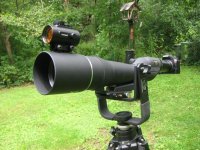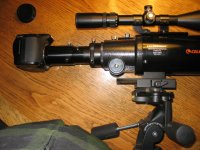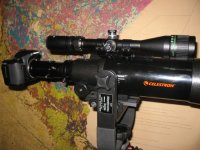This is to inform all interested that the indefatigable Dutch birding optics expert Jan Meijerink has posted beautifully conducted tripod and head tests on the Twentse vogelwerkgroep site: http://www.tvwg.nl/ You will find it under "testrapportten," one of the site tabs on the left of the main page.
The test is in Dutch, but he has photographic data on each tripod and head, where you can see the vibrations induced by either a single tap on a mounted scope or a swinging pendulum attached to the scope to test torsional rigidity of the setup. He uses a single light point target placed a distance away, and has digitally photographed this target through the telescope set on a tripod. Several of the relevant Manfrotto, Gitzo and Berlebach models are included, but of course not all the models one might wish to see. An interesting and important part of the test is the timing with a stopwatch of how long it takes for vibrations to dampen after a single impulse. Here, one can see very clearly how aluminum continues to "ring" much longer than carbon fibre or wood. Another thing that interested me was how between the two Manfrotto 128 heads tested, the non-QR long-plate version was significantly more stable than the QR-version which is otherwise identical.
I don't recall any tripod tests from the recent years that would have been conducted with anything like this level of consistency, precision and thoroughness. Take a look and post your impressions.
Kimmo
The test is in Dutch, but he has photographic data on each tripod and head, where you can see the vibrations induced by either a single tap on a mounted scope or a swinging pendulum attached to the scope to test torsional rigidity of the setup. He uses a single light point target placed a distance away, and has digitally photographed this target through the telescope set on a tripod. Several of the relevant Manfrotto, Gitzo and Berlebach models are included, but of course not all the models one might wish to see. An interesting and important part of the test is the timing with a stopwatch of how long it takes for vibrations to dampen after a single impulse. Here, one can see very clearly how aluminum continues to "ring" much longer than carbon fibre or wood. Another thing that interested me was how between the two Manfrotto 128 heads tested, the non-QR long-plate version was significantly more stable than the QR-version which is otherwise identical.
I don't recall any tripod tests from the recent years that would have been conducted with anything like this level of consistency, precision and thoroughness. Take a look and post your impressions.
Kimmo






